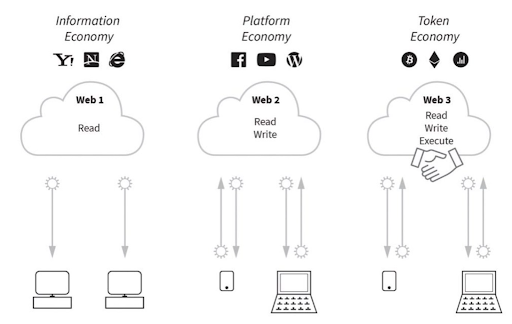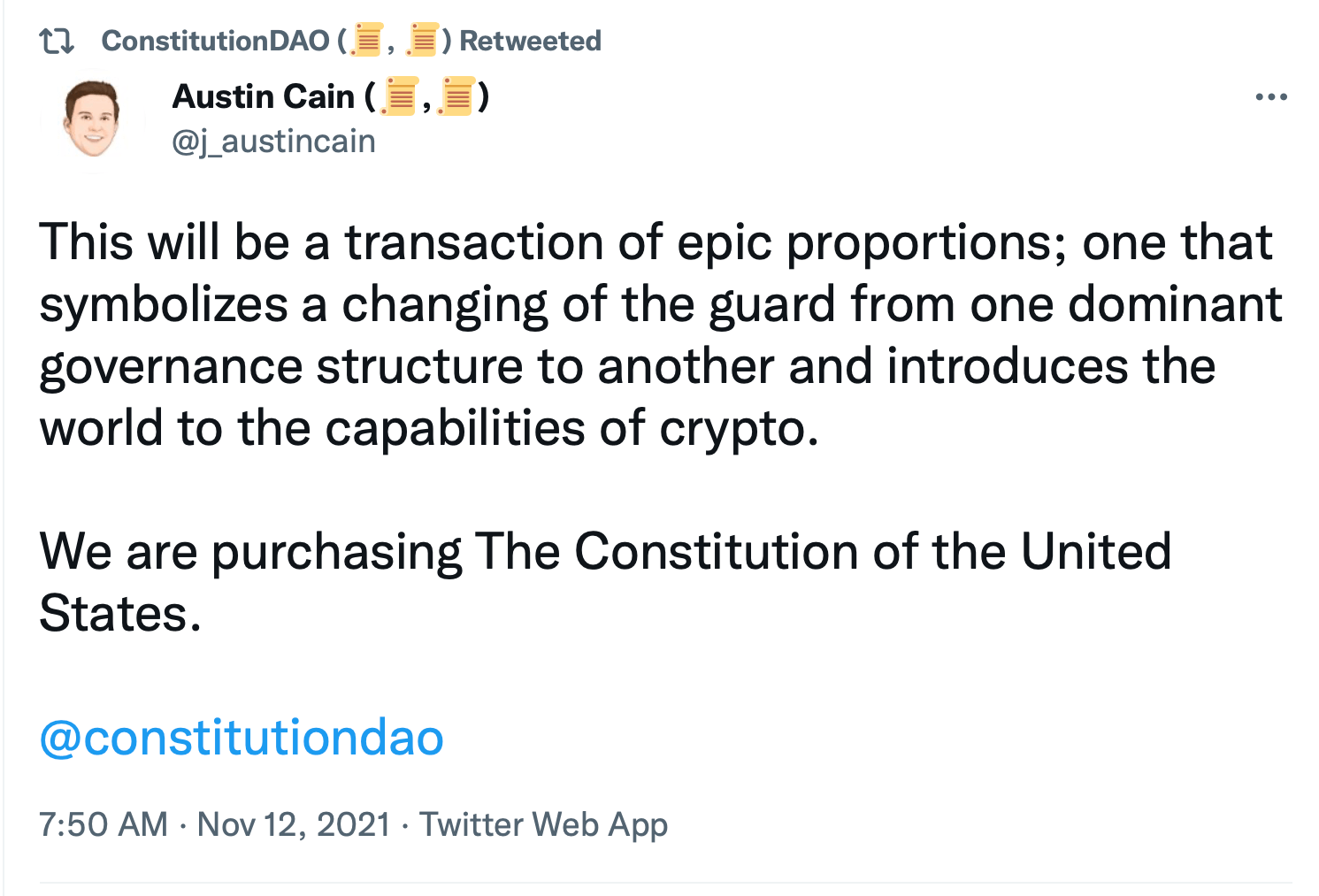

Burak Arik is the CEO & co-founder of entrapeer. He is also a tech-passionate computer engineer turned innovation expert.
Below, we share his insights into the future of the internet and why your enterprise (or startup) should care about the emergence of Web3 and Web3 companies.
Web1 and the Wild West
Flashback to 1997, when the Internet was still in its infancy. When dial-up modems ushered us into the world wide web with grating sounds like some kind of alien space transmission.
Back then, I was a computer engineering student. We used Netscape Navigator to bounce between static web pages and read whatever was published without offering up our own opinions (no comments, likes, or hearts back then).
Hypothetically, this proto-Internet (now referred to as Web1) was an open environment. Anyone could publish their own content – the problem was that few knew how to. So companies that had the money and expertise developed web pages for profit.
Additionally, there weren’t standalone servers or data centers as there are today. Regular computers spread across vast distances operated as our “servers.” The inventor of the Web, Tim Berners-Lee, recalls that these computers were often marked with stickers that said: “This machine is a server. Do not power it down!” Unsurprisingly, the connection speed was agonizingly slow.

On the left, Tim Berners-Lee’s Web1.0 Server
This read-only internet – which lasted from 1990-2005 – is now referred to as Web1.
Social media & mobile forever change the internet
The year 2000 marked a new era with the emergence of social media, cloud computing, mobile technologies, and faster connection speeds. In 2003, Facebook (then Facemash) took root as Harvard University students ventured into the Wild West of the internet. Simultaneously, Yonja launched in Turkey to great success. But while Facebook went global in 2006, Yonja silently faded to the background (though it maintains a lingering presence as a dating site).
In 2005, YouTube came onto the scene, followed by Twitter in 2006. But the impact of social media really gained speed when the iPhone launched in 2007. Suddenly, advances in telecom infrastructures such as GRPS/EDGE allowed us to access the internet any time of the day, almost anywhere we went (so long as there was cell reception).
Soon mobile applications made access to our Internet haunts even easier, with the launch of Apple’s App Store in 2008. The dramatic improvement in user experience meant that mobile browsing increased day by day, and soon a read-write platform replaced Web1’s read-only structure. Now users could easily create and publish content without the technical expertise that the early internet required.
To accommodate this surge in mobile internet traffic, providers needed to build specialized servers. And rather than rely on dispersed servers, providers decided to concentrate their servers in distinct silos and transition to cloud computing. Thus the data center was created.
This second evolution of the internet – from 2005 to the present – is known as Web2.
Web2 privileges profit over privacy
There were a lot of differences between Web1 and 2, but the most fundamental is this: while companies produced and controlled content in Web1, Web2 democratized content creation, allowing anyone with a cell phone to post whatever they wanted – even bad selfies and silly cat videos.
Seems like a positive change, right?
Well, the thing is that while users are the ones generating the content, the technology giants are the ones profiting from that content. Tech companies are now the largest in the world thanks to the content we produce and the personal information we unwittingly (or wittingly) share through our search history and browsing behavior.
Consumers today are far more informed about the tracking of our behavior and the sale of our data than we were even 10 years ago. And still, these companies collect gigabytes of data that is “undisclosed to us” because we resignedly accept the terms and conditions.
This data presents a unique opportunity for companies to create targeted advertisements in the hopes of driving casual web browsers to some action, whether that is purchasing a product or signing up for a webinar. In Meta’s case, advertisers can choose from 98+ distinct data points, including age, gender, location, education level, language, political views, last vacation destination…the list goes on.
Aside from using this data on their own platforms, tech companies also share it with their partners. Look no further than the Cambridge Analytica-Facebook scandal.
While it’s easy to be critical of such questionable use of personal data, it’s important to remember that these Web2 tech companies are, in fact, for-profit businesses. Google, Meta, and Twitter all have thousands of employees on payroll and spend billions of dollars on their infrastructure.
It is naive for us to assume that these companies should provide us with these services for free. As a general rule, if you use a free platform or product on Web2, then you are the product. Your activity and personal data generate revenue for the service provider so that you may freely use that service.
This might have sounded like something out of a dystopian sci-fi novel 20 years ago. But today, we are inured to targeted advertising and customized spam. We assume a lack of privacy in all our digital interactions. Just look at the mantra: “the Internet is forever.”
What’s more, we’ve become more accustomed to massive data breaches and hackers. In 2020 alone, 37 billion user registration lines were scattered as a result of approximately 4000 data breaches in the USA.1
So what can we do to win back more autonomy over our data and how it’s used?
Consumers demand transparency (and a share of the data pie)
The good news is that we don’t have to resign ourselves to a world without true data privacy. The tides are changing.
Last year, Apple shook the mobile marketing world with its ATT (App Tracking Transparency) feature (released in iOS 14.5). For the first time, users were given the option to “Ask App Not to Track” when downloading or opening a new app. Shortly after this release, Flurry Analytics found that only 23% of users allowed tracking when prompted.2 While this paints a dire picture for companies dependent on mobile marketing, it could mean more freedom from the invasive tactics and manipulative UX design of digital advertising.
Another response to the data privacy issue is the concept of profit sharing. In this scenario, profits generated from user data would be passed on to the user. This approach has gained popularity as the creator economy has grown. Today, millions view digital content creation and community building as a legitimate livelihood. In fact, the pandemic gave rise to a surge of new creators – a trend that has continued through 2021 with an increase of 48% as compared to 2020.3
In this new cultural climate, consumers have come to demand that profits derived from their data and content be shared more equitably. Sounds pretty nice, doesn’t it?
An open, distributed system where the user has sovereignty over their data usage, and revenue derived therefrom?
Welcome to the world of Web3.
Web2 vs. Web3: Why is it important?

Web1 vs. Web2 vs. Web3
Web3 builds upon the best of Web1 and Web2 to establish a new paradigm for our digital lives. It redefines Web1’s distributed nature through community-managed content and builds on Web2’s technological innovations to provide a richer, more empowering user experience.
Where Web1 was read-only and Web2 was read-write, Web3 offers the promise of a read-write-execute model – meaning users will have more control over how their content and data are used.
How? The simple answer is: Blockchain.
In a nutshell, blockchain functions as a computer that is accessible to anyone but owned by no one. This means that users can interact with one another without the need for a server, intermediary, or trust authority (i.e. big tech).
Up until now, user trust has been a social phenomenon that emerged over time. Today, institutions must work harder to gain the trust of their audience “from the top down.”
Blockchain operates differently. It mathematically secures the element of trust on crypto networks using methods such as proof-of-work or proof-of-stake. Smart contract Blockchain networks such as Ethereum establish “programmable trust” from the bottom up, starting with individuals/software. In this way, Ethereum is a globally distributed computer owned and operated by Ethereum users.
In Web3’s case, users will own and operate the network via tokens. This means that – for the first time in history – users don’t have to rely on third-party servers, which run the risk of crashing or getting hacked. Instead, Blockchain allows for a distributed, consistent and country-bound experience that will never crash.
In summary, the basic principles of Web3 are:
- A distributed system that doesn’t require any central authorities.
- Trust is not placed in a company or institution but rather in mathematics.
- The network is community-managed (not company-owned).
- Users can utilize services without the need for permission.
- No one can ban you, censor you, or block your access.
- Payments are made via tokens.
- Almost any application can be programmed with smart contract protocols.
- Profits go to the creator. This could be an app developer or content creator.
About these tokens…
You might be wondering, “What are these tokens?”
Unless you’ve been living under a rock, you’ve probably already heard of them since these multimillion-dollar assets have caused quite a buzz in the past few years. That’s right, we’re talking about NFTs.
NFTs (Non-Fungible Tokens) act as digital certificates of ownership. While a Bitcoin is “fungible” (meaning it can be traded for another Bitcoin of equal value), an NFT is “non-fungible” because it is one-of-a-kind.
In Web3’s case, NFTs help ensure that the creator reaps the rewards of the content they produce. But NFTs go beyond digital art: they can be any digital asset, including code, games, administrative authority, or even Metaverse properties. For example, a virtual shop on Decentraland was bought for $2.4M. Meanwhile, in Sandbox, the starting price for the least desirable real estate starts at $25K.
Fungible tokens, namely cryptocurrencies that have a standard value, will also find their place on Web3.
What are the benefits of Web3?
1. Easier, safer logins.
Unlike Web2, which requires users to create unique usernames and passwords for each service, Web3 users will be able to store all their information in a digital “wallet.” This wallet will then grant access to all services.
Although social login methods such as “Login with Facebook” and “Login with Google” remain popular, these methods still require us to trust a central company (thus increasing the risk should that company be hacked). Web3, on the other hand, offers a decentralized, community-controlled, and secure authentication mechanism.
2. Digital wallets for simple token management.
Not only will the digital wallet store our personal data and login information: but it will also keep that data up-to-date, so your info across all services is consistent and timely.
The downside is that private keys are not easy to read and share because the wallet addresses are too long and complex. However, this issue is easily remedied with the ENS Ethereum Name Service (ENS) project, which allows you to name your wallet addresses.
3. Zero-knowledge proofs.
One of Web3’s greatest technological advances for privacy is ZKP (zero-knowledge proofs). In short, ZKP allows parties involved in the blockchain network to trust and approve data without seeing any of the transaction details. They answer the question: “How can I prove the information I provide is accurate without giving the information to someone else?”
4. The future of finance is decentralized.
The distributed, agentless nature of Web3 has interesting implications for the future of finance – especially decentralized finance (DeFi). DeFi refers to the entire ecosystem of blockchain-enabled financial products and services. This burgeoning sector aims to provide financial products and services without banks as intermediaries.
Thanks to the development of faster, cheaper protocols such as Solana, Avalanche, and Polygon, DeFi has grown exponentially in the past two years. According to some estimates, the total amount of money (TVL) stored in DeFi applications went from $1 billion in June of 2020 to $270 billion as of November 2021.4 Of course, this figure has since plummeted to $64 billion as of August 20th, 2022 – but that’s still 64 times what it was just 2 years ago…

5. DAOs.
With the rise of decentralized finance, organizations have formed to collect and allocate crypto resources toward projects of interest. These entities are called DAOs, or decentralized autonomous organizations.
Essentially, DAOS are like digital cooperatives managed by their participants through governance tokens. Perhaps the most (in)famous example of this is ConstitutionDAO, which famously raised an average of $206 USD from over 17,000 participants – using their custom $PEOPLE token – to bid on Sotheby’s copy of the American Constitution.
Despite losing the auction, ConstitutionDAO taught some valuable lessons about how users can leverage the inherent strengths of crypto to accomplish what conventional organizations cannot. Proponents argue that as DAOs become more sophisticated, they will be more transparent, more democratic, and more agile than traditional enterprises. But without current success stories to draw from, only time will tell.
But how will Web3 companies generate revenue?
As described above, Web2 companies rely on advertising to generate revenue. Web3 takes a different approach.
Web3 positions users as shareholders. They are owners and creators that contribute to the growth of the network, and so profit is distributed to the users and developers who constitute this network at the edge, instead of going to central companies.
In this context, Web3 companies don’t have to rely on ads for growth, and tokens become marketing tools. Token owners become ambassadors for the application since they carry a tidbit of business’ financial risk. As such, fair distribution of tokens is a critical issue in Web3. A healthy community can only form when ownership is equitably distributed.
Let’s look at some examples across various sectors:
- Social media. Social media platforms like Facebook, Instagram, and TikTok do not share income with content creators. By contrast, Web3 social media users – using apps like Diamond, Overclout, and Desofy – can “engage and earn” by creating content, communicating, and connecting with one another.
- Gaming. The gaming industry is another example where players generate immense value yet don’t traditionally receive any profit for their effort. The Web3 platform Axie Infinity – developed by Vietnamese Sky Mavis studios – takes only 4.25% of the game winnings and distributes the rest back to players. The platform’s proceeds are then used to fund other peer-to-peer players. According to CNBC’s report, Axie Infinity has become a primary source of income for many people in the Philippines.
- Telecom. Helium uses a device called Hotspot to loop its users in the Blockchain network via radio communication. In this way, Helium bypasses the need for a central telecom company and connects users to the Internet. The resulting profit is then shared with users.
As Web3 grows, we’re sure to see more innovative, distributed profit-sharing models across all sectors.
Web2 vs. Web3: cut-rate and opportunity
Jeff Bezos is reported to have said, “Your profit margin is my opportunity.”
I think it’s fair to say that Web2’s cut rate is Web3’s opportunity. Web3 companies will provide important opportunities for all of us to reimagine what it means to be a part of a digital community – whether that’s through gaming, content creation, or crowd-funding. But one thing is clear: Web3 makes it possible for all of us to be pioneers of transformation, shaping a more democratic and equitable internet future.
1 Whitney, L., Staff, T. R., Shein, E., Miles, B., Eckel, E., & Asay, M. (2021, January 21). 2020 sees a huge increase in records exposed in data breaches. TechRepublic. Retrieved August 23, 2022, from https://www.techrepublic.com/article/2020-sees-huge-increase-in-records-exposed-in-data-breaches/
2 Balasubramanian, M. (2022, May 2). App Tracking Transparency Opt-in rate – monthly updates. Flurry. Retrieved August 23, 2022, from https://www.flurry.com/blog/att-opt-in-rate-monthly-updates/
3 Wee, E. (2021, October 21). Indexing the creator economy. Retrieved August 23, 2022, from https://stripe.com/blog/creator-economy
4 Softtech 2022 Technology Report. Softtech. (n.d.). Retrieved August 23, 2022, from https://softtech.com.tr/en/2022-softtech-technology-report/

